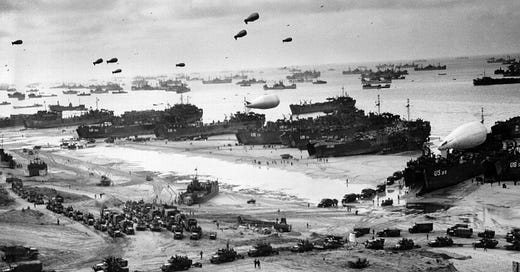Read the other articles in my series on Invasion Antwerp 1944 (an alternate military history):
Choosing a landing location for D-day 1944 (this article)
How would the German army respond? (upcoming)
As I mentioned in the first article, the key decisions for planning D-day were:
When?
Where?
The when was mainly determined by politics and the realization the inexperienced American troops could not carry out a successful amphibious assault in Northwest Europe in 1943.
The weather meant that it had to be in May or June 1944. The original date was May 1, 1944, but it was pushed back to early June because the Allies had still not acquired the necessary number of troops in the UK.
Criteria for determining the landing location
The following were important criteria that Allied planners used in determining the beach landing place (roughly in order of importance):
Air miles from air bases in England (fighter cover and bombing support was critical)
Nautical miles from ports in England (critical for minimizing the vulnerability of naval ships and transport)
Proximity to port(s) and the characteristics of those ports including:
Quantity of Throughput (number of tons that could be off-loaded from cargo ships to the port in one day)
Quantity of Clearance (number of tons that could be cleared out of port via trains, barges, or trucks in one day). This number was the most important. The bottleneck was typically not getting cargo into ports, but getting cargo out of ports.
Number and length of quays (i.e. how many ships could be handled at one time)
Depth of water next to quays (potentially limits the size of cargo ships that could be docked). Ideally, this should be large enough to support Liberty ships coming directly from the USA, rather than smaller coasters coming from the UK.
Depth and width of approaches to port (potentially limits the size of cargo ships)
Defensibility from German counter-attack
Facilities (including cranes, loading bridges, warehouses, grain elevators, petroleum storage tanks, etc)
Links to ground transportation (rail, highways, and canals)
Beach characteristics:
Surface (i.e. sandy, rocky, or cliffs)
Slope
Depth
Tidal range
Number and size of exits from the beach
Elevation gain at the inland edge of the beach
Distance from Germany, particularly the Ruhr regions
Known German defenses:
Fortifications behind beaches
Army and SS unit locations, particularly Panzer divisions
Coastal artillery emplacements (number and size)
Areas beyond the beach for supply depots (must be a large and flat area)
Terrain beyond the beaches.
Roads and rail lines from near the beach to the rest of the transportation network.
Weather patterns, including:
Precipitation
Cloud cover (for flying)
Waves
Frequency of major storms
Known German naval ports and activities (typically E-boats and submarines).
Known German air bases within range
Potential support from friendly locals
There are probably some other factors that I missed and some that are ranked too high or low, but this list should give you some idea of the complexity of deciding on a landing location.
The advantages of each side
What made things worse was that the Germans typically had better information than the Allies, and they could pivot their plans much faster. Allied operations after July 1944 were largely improvised, but the planning for D-day was literally down to the minute. It was like a dance choreography that required months of practice. And the plan would have to undergo significant changes if the generals suddenly changed the beach location. By spring 1944, the landing location could not be changed. Only the date could be pushed back by a few days.
This meant that the Germans always had the final vote. This made the Allied beach selection a bit of a game of:
“I know that he knows, but he knows that I know, so…. But then if he knows, that I know that I will do that, then I should ….”
This is a bit of an unresolvable dilemma, but at some point, a decision had to be made.
The main advantages that the Allies had in 1944 were:
A Soviet steam-roller in the East and
An American/British steam-roller in the West (if they could establish a beachhead).
Air superiority
Naval superiority (the U-boat menace ended in the summer of 1943)
But would these advantages be enough to translate into a successful amphibious assault?
Read the other articles in my series on Invasion Antwerp 1944 (an alternate military history):
Choosing a landing location for D-day 1944 (this article)
How would the German army respond? (upcoming)






